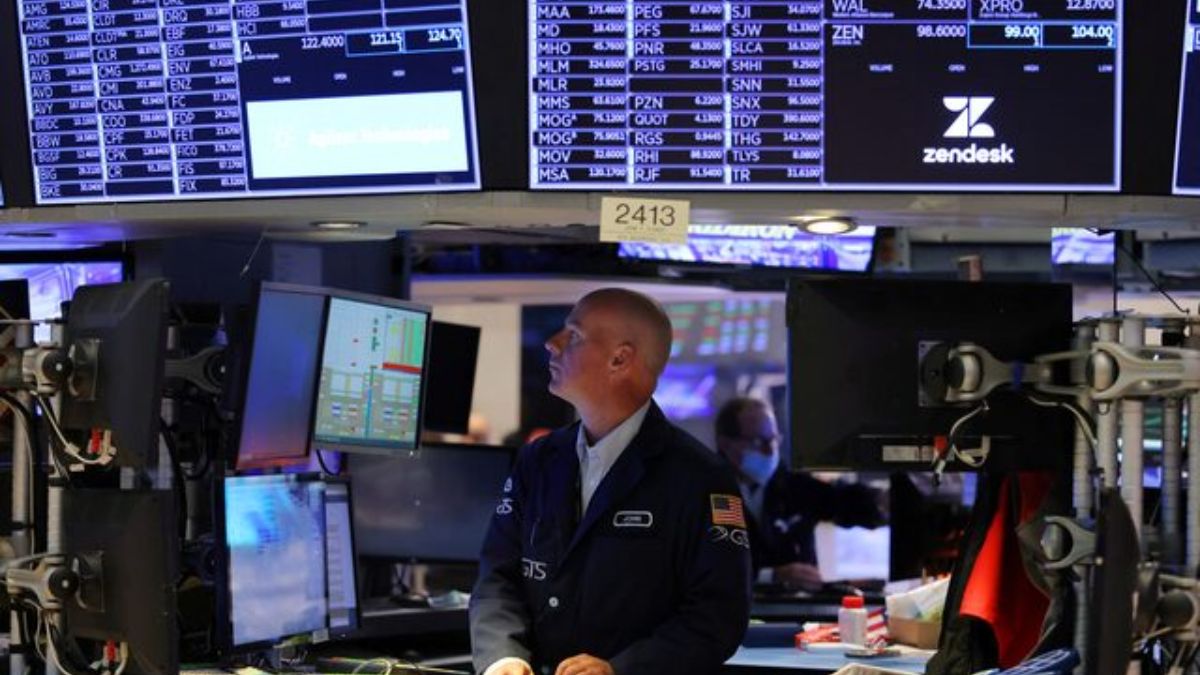Monday witnessed stock markets crashing all over the world.
The Sensex is down 3.31 per cent or 2,686.09 points at 78,295.86, while the NSE Nifty slid 824 points or 3.33 per cent to 23,893.70.
Indian investors saw Rs 17.11 lakh crore of wealth wiped out.
Japan’s Nikkei 225 has plunged over 12 per cent to 31,458.42.It dropped 5.8 per cent on Friday and has now logged its worst two-day decline ever, dropping 18.2 per cent in the last two trading sessions.
The Taiex, the weighted index on the Taiwan Stock Exchange, was down 8.35 percent at 19,830.88 by the close of morning trade at 1:30 pm with chip giant TSMC off 9.3 percent.
South Korea’s Kospi fell by 9 per cent, while Shanghai and Hong Kong were also trading sharply lower at 2.6 per cent and 1.2 per cent.
This comes days after Wall Street fell 610 points with Microsoft and Amazon witnessing heavy losses.
Monday’s stock market crashes – particularly in Japan – are being compared to one of the worst days in global financial history which occurred in 1987 – known as Black Monday.
But what happened back then? And why did it happen? What was the aftermath?
Let’s take a closer look:
What happened?
Black Monday occurred on October 19, 1987.
It was a bloodbath for indices all over the world.
Impact Shorts
More ShortsAccording to Federal Reserve History, it all began with stock markets in and around Asia plunging.
In Asia, Japan’s Nikkei lost 14.9 per cent or 3,836 points, while Hong Kong’s Hang Seng Index’s RSI crashed 40 per cent.
Then, the US markets opened to utter chaos.
The Dow Jones Industrial Average plunged 22.6 per cent in a single trading session, while the S&P 500 plunged 30 per cent.
It was the biggest US stock market loss since the Great Depression.
“People were coming out for their smoking breaks and they looked shell-shocked, _NPR’_s former economic correspondent Barbara Mantel reported. “They were using words like hysteria, panic to describe what was going on inside.”
The contagion then spread to Europe.
In the UK, the London stock market fell by 22 per cent over two days.
Of all the markets that were in the red, Austria was the least affected at a loss of 11.4 per cent.
Interestingly, the Sensex, which had only launched in 1986, actually closed higher.
Around 1.71 trillion is thought to have been wiped out across the world.
The events of Black Monday shook up investors and raised the spectre of a repeat of the Great Depression.
Why did it happen?
According to Investopedia, there was no single precipitating event that caused Black Monday.
Instead, several events occurred that created a perfect storm for investors.
As per Federal Reserve History, the federal government unveiled a bigger trade deficit than expected. The dollar also fell in value.
Experts also think that the markets, which had been on a major bull run since 1982, were ripe for correction.
Computerised trading, also known as program trading, is also thought to have played a part. Portfolio insurance – which short-sells index futures to keep potential stock losses in check – is thought to have been a key factor in the new-fangled computerised trading. The computer programs essentially began selling stocks – thus creating a domino effect.
Meanwhile, the Friday before the crash also saw ‘triple witching’ – when stock options, stock index futures, and stock index options contracts expired simultaneously.
This, naturally, caused major instability in the final few hours of Friday trading and later spilled over to Monday.
Finally, experts blame mass hysteria – essentially a herd mentality taking over among investors – for the major decline.
“There is so much psychological togetherness that seems to have worked both on the up side and on the down side,” Andrew Grove, chief executive of technology company Intel Corp was quoted as saying by the website.
“It’s a little like a theatre where someone yells ‘Fire!’
The aftermath
US Federal Reserve chairman Alan Greenspan said, “The Federal Reserve, consistent with its responsibilities as the Nation’s central bank, affirmed today its readiness to serve as a source of liquidity to support the economic and financial system.”
As per Investopedia, the US Federal Reserve acted immediately by cutting interest rates half a percentage point.
This, it hoped, would encourage liquidity in the market. It also funnelled billions of dollars into the economy through quantitative easing – buying bonds to push up their prices and bring down interest rates.
Regulators also introduced circuit-breakers for the first time to prevent crashes through computerised trading.
These would immediately halt trading in case of unusual drops or rises on stock exchanges.
For example, the New York Stock Exchange now temporarily halts trading when the S&P 500 stock index declines 7 percent, 13 percent, and 20 percent.
As its website explains, “In response to the market breaks in October 1987 and October 1989, the New York Stock Exchange instituted circuit breakers to reduce volatility and promote investor confidence. By implementing a pause in trading, investors are given time to assimilate incoming information and the ability to make informed choices during periods of high market volatility.”
Diana B Henriques, author of A First-Class Catastrophe: The Road to Black Monday, the Worst Day in Wall Street History summed up the aftermath of the day to _NPR, “_It wasn’t like any previous market crash and yet, every crash since has been similar to 1987.”
“Not only was Black Monday worse than we remember today; it was worse than we knew at the time,” Henriques added. “Some events are important because of what they reveal, what they show us about the world we’re living in. And that was what made the 1987 crash so important.”
With inputs from agencies
)